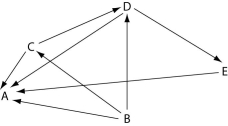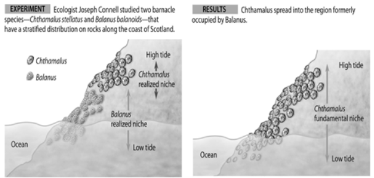A) mutualism
B) parasitism
C) commensalism
D) facilitation
E) competition
G) A) and C)
Correct Answer

verified
Correct Answer
verified
Multiple Choice
Use the following diagram of a hypothetical food web to answer the following questions. The arrows represent the transfer of food energy between the various trophic levels.
 Figure 54.3
-Which letter represents an organism that could be a producer?
Figure 54.3
-Which letter represents an organism that could be a producer?
A) A
B) B
C) C
D) D
E) E
G) A) and C)
Correct Answer

verified
Correct Answer
verified
Multiple Choice
Which of the following best describes resource partitioning?
A) competitive exclusion that results in the success of the superior species
B) slight variations in niche that allow similar species to coexist
C) two species that can coevolve to share identical niches
D) differential resource utilization that results in a decrease in community species diversity
E) a climax community that is reached when no new niches are available
G) D) and E)
Correct Answer

verified
Correct Answer
verified
Multiple Choice
As you study two closely related predatory insect species, the two-spot and the three-spot avenger beetles, you notice that each species seeks prey at dawn in areas without the other species. However, where their ranges overlap, the two-spot avenger beetle hunts at night and the three-spot hunts in the morning. When you bring them into the laboratory and isolate the two different species, you discover that the offspring of both species are found to be nocturnal. You have discovered an example of
A) mutualism.
B) character displacement.
C) Batesian mimicry.
D) facultative commensalism.
E) resource partitioning.
G) A) and B)
Correct Answer

verified
Correct Answer
verified
Multiple Choice
The most plausible hypothesis to explain why species richness is higher in tropical than in temperate regions is that
A) tropical communities are younger.
B) tropical regions generally have more available water and higher levels of solar radiation.
C) higher temperatures cause more rapid speciation.
D) diversity increases as evapotranspiration decreases.
E) tropical regions have very high rates of immigration and very low rates of extinction.
G) A) and C)
Correct Answer

verified
Correct Answer
verified
Multiple Choice
The next series of questions presumes that you have at least once visited and have some knowledge of the fast-food restaurant McDonald's. Use your knowledge of McDonald's and your understanding of community ecology to answer the following questions about an ecological community, McDonaldland. -Which of the following would be considered a keystone species in McDonaldland?
A) Big Mac
B) Large French Fries
C) Premium Caesar Salad with Crispy Chicken
D) Filet-O-Fish
E) Chicken McNuggets
G) All of the above
Correct Answer

verified
Correct Answer
verified
Multiple Choice
Resource partitioning would be most likely to occur between
A) sympatric populations of a predator and its prey.
B) sympatric populations of species with similar ecological niches.
C) sympatric populations of a flowering plant and its specialized insect pollinator.
D) allopatric populations of the same animal species.
E) allopatric populations of species with similar ecological niches.
G) B) and D)
Correct Answer

verified
Correct Answer
verified
Multiple Choice
The symbols +, -, and o are to be used to show the results of interactions between individuals and groups of individuals in the examples that follow. The symbol + denotes a positive interaction, - denotes a negative interaction, and o denotes where individuals are not affected by interacting. The first symbol refers to the first organism mentioned. -What interactions exist between a bee and a flower?
A) +/+
B) +/o
C) +/-
D) o/o
E) -/-
G) All of the above
Correct Answer

verified
Correct Answer
verified
Multiple Choice
The 1988 Yellowstone National Park lodgepole pine forest fires were likely the result of
A) overgrazing by elk.
B) infrequent rain episodes.
C) years of fire suppression by humans.
D) unextinguished campfires.
E) geysers.
G) C) and D)
Correct Answer

verified
Correct Answer
verified
Multiple Choice
The symbols +, -, and o are to be used to show the results of interactions between individuals and groups of individuals in the examples that follow. The symbol + denotes a positive interaction, - denotes a negative interaction, and o denotes where individuals are not affected by interacting. The first symbol refers to the first organism mentioned. -The feeding relationships among the species in a community determine the community's
A) secondary succession.
B) ecological niche.
C) species richness.
D) species-area curve.
E) trophic structure.
G) All of the above
Correct Answer

verified
Correct Answer
verified
Multiple Choice
Use the following diagram to answer the next question
 -Connell conducted this experiment to learn more about
-Connell conducted this experiment to learn more about
A) character displacement in the color of barnacles.
B) habitat preference in two different species of barnacles.
C) desiccation resistance and barnacle species.
D) how sea-level changes affect barnacle distribution.
E) competitive exclusion and distribution of barnacle species.
G) D) and E)
Correct Answer

verified
Correct Answer
verified
Multiple Choice
The next series of questions presumes that you have at least once visited and have some knowledge of the fast-food restaurant McDonald's. Use your knowledge of McDonald's and your understanding of community ecology to answer the following questions about an ecological community, McDonaldland. -Which two "species" are likely to compete for the same ecological niche?
A) Big Mac and Quarter Pounder
B) French Fries and Hash Browns
C) Premium Caesar Salad with Crispy Chicken and Premium Crispy Chicken Classic Sandwich
D) Filet-O-Fish and Double Cheeseburger
E) No two species can ever occupy the same ecological niche.
G) A) and C)
Correct Answer

verified
Correct Answer
verified
Multiple Choice
Which of the following would be most significant in understanding the structure of an ecological community?
A) determining how many species are present overall
B) determining which particular species are present
C) determining the kinds of interactions that occur among organisms of different species
D) determining the relative abundance of species
E) determining how many species are present overall, which particular species are present, the kinds of interactions that occur among organisms of different species, and the relative abundance of species
G) B) and D)
Correct Answer

verified
Correct Answer
verified
Multiple Choice
The oak tree pathogen, Phytophthora ramorum, has migrated 650 km in 10 years. West Nile virus spread from New York State to 46 other states in 5 years. The difference in the rate of spread is probably related to
A) the lethality of each pathogen.
B) the mobility of their hosts.
C) the fact that viruses are very small.
D) innate resistance.
E) dormancy viability.
G) All of the above
Correct Answer

verified
Correct Answer
verified
Multiple Choice
How might an ecologist test whether a species is occupying its realized or its fundamental niche?
A) Study the temperature range and humidity requirements of the species.
B) Observe if the niche size changes after the addition of nutritional resources to the habitat.
C) Observe if the niche size changes after the introduction of a similar non-native species.
D) Measure the change in reproductive success when the species is subjected to environmental stress.
E) Remove a competitor species to see if the species expands its range.
G) B) and E)
Correct Answer

verified
Correct Answer
verified
Multiple Choice
The symbols +, -, and o are to be used to show the results of interactions between individuals and groups of individuals in the examples that follow. The symbol + denotes a positive interaction, - denotes a negative interaction, and o denotes where individuals are not affected by interacting. The first symbol refers to the first organism mentioned. -What interactions exist between a lion pride and a hyena pack?
A) +/+
B) +/o
C) +/-
D) o/o
E) -/-
G) A) and D)
Correct Answer

verified
Correct Answer
verified
Multiple Choice
Use the following diagram of five islands formed at around the same time near a particular mainland, as well as MacArthur and Wilson's island biogeography principles, to answer the following questions.
 Figure 54.4
-Which island would likely exhibit the most impoverished species diversity?
Figure 54.4
-Which island would likely exhibit the most impoverished species diversity?
A) A
B) B
C) C
D) D
E) E
G) A) and B)
Correct Answer

verified
Correct Answer
verified
Multiple Choice
Evidence shows that some grasses benefit from being grazed. Which of the following terms would best describe this plant-herbivore interaction?
A) mutualism
B) commensalism
C) parasitism
D) competition
E) predation
G) B) and D)
Correct Answer

verified
Correct Answer
verified
Multiple Choice
According to the equilibrium model of island biogeography, species richness would be greatest on an island that is
A) large and close to a mainland.
B) large and remote.
C) small and remote.
D) small and close to a mainland.
E) environmentally homogeneous.
G) All of the above
Correct Answer

verified
Correct Answer
verified
Multiple Choice
According to bottom-up and top-down control models of community organization, which of the following expressions would imply that an increase in the size of a carnivore (C) population would negatively impact on its prey (P) population, but not vice versa?
A) P ← C
B) P → C
C) C ↔ P
D) P ← C → P
E) C ← P →
G) A) and B)
Correct Answer

verified
Correct Answer
verified
Showing 41 - 60 of 77
Related Exams